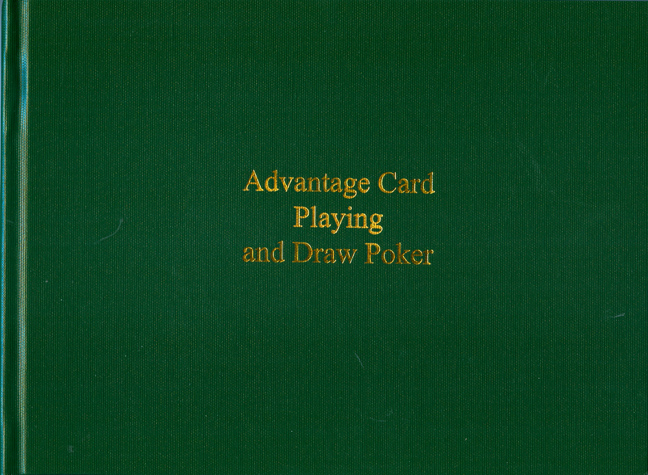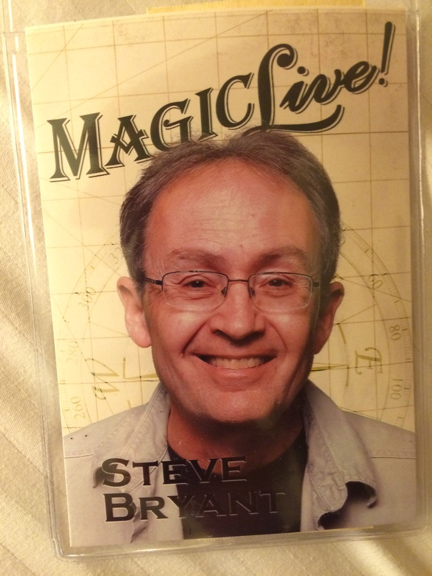
|
Note ye ed's email address: stevebryant99@gmail.com. |


Mike Michaels production gaffus.
|
Last month's August issue covered the first six MAGIC Live conventions (staggering!) and a favorite trick from my high school days, reborn. |
September 2015 Congratulations to Joshua Jay and Andi Gladwin for each adding a member to his family, Josh via marriage to Anna and Andi through the birth of his son, Joseph. This couldn't happen to nicer (or busier) guys. This month, during my brief stopover at home between trips to Florida, we also mention the terrific MAGIC Live recently held in Las Vegas, Geno Munari's publication of a seminal book on cheating at poker, and a return to Magic Monday, my once upon a time work venue. Next, I hope to see all at the Genii convention, just days away. It should be awesome. |
|
|
EXPERTISE AT THE CARD TABLE --In January 2011, a copy of the 1905 F.R. Ritter book, Combined Treatise on Advantage Playing and Draw Poker, exchanged hands for a record (including Potter and Potter auction premium) $19,200. Thanks to a handsome and enhanced reprint from Geno Munari, you can acquire a copy of this fascinating work for much, much less. According to David Ben's biography of Dai Vernon (Part 1), this is the book on card cheating that Vernon's father described over dinner, and which Vernon thought to be Erdnase's book when the lad purchased it six weeks later. There are marked differences: Ritter was illustrated with photos, Erdnase with line drawings, for example. But also marked similarities. Despite Ritter's prospectus assertion that he had thoroughly investigated every book and treatise on draw poker and advantage card play and found "all of them of little or no value," he had clearly read Erdnase and found, if not content, then at least language of value. The opening line of Ritter's Introduction reads, "The passion for play is probably as old and will be as enduring as the race of man." Erdnase students will recognize the exact same sentence (with the addition of a couple of commas) as the opening line to Erdnase's Introduction. Ritter's Dedication contends, "It will not make the novice a cheater, nor transform the pastime player into a professional." Compare this to the phrasing in Erdnase's Preface: "But it will not make the innocent vicious, or transform the pastime player into a professional." And both gentlemen have their tongue in cheek (my opinion here; some Erdnase hunters strongly disagree) when it comes to the financial motivation for writing: Erdnase ("... if it sells, it will accomplish the primary motive of the author, as he needs the money.") vs. Ritter ("It is my object in writing these treatises ... to make some money for the Author.").  How to be "bad" at poker. The bulk of the original text plays out in three treatises. The first deals with marked cards, which Ritter broke down into scroll work, line work, shade work, and blot-out work. It provides 71 pages of photographic examples as applied to popular back designs of the day. The second treatise covers physical and mechanical examples of advantage play. It's a brief section (12 pages) on false deals, false cuts, and holdouts along with one excellent page on strategies. The third treatise is on old and new hands (new, maverick rules for poker games) and an ample supply of lists of numbered Don'ts, Tips, Rules, and Strong Plays. The new games, new to me at least, include such hands as Skips (2,4,6,8,10 of mixed suits, with a Skip beating an ordinary Straight). It might be fun to return to the gaming table with my friends and try these out. The various lists are interesting, ranging from sensible wagering advice to etiquette to common sense (Don't play more than eight hours at a stretch) to math-based advice. My sixth sense says to take that last category with a grain of salt. The new edition also includes a nicely researched biographical article from Bill Mullins ("Fred Ritter: Mail-Order Card Sharp"), a letter from Ritter to a prospective customer (he is anything but modest), and "Confidential Tips" on the game that he marketed separately. Geno has printed 350 copies in a handsome hardbound edition with glossy pages and 600 softbound reduced copies. Erdnase collectors and scholars will consider this a must, both for its differences and its similarities, and it should also delight general students of gambling technique and lore. Geno has posted on the Genii forum that it sells for $95 with a prepublication offer of $85. The soft cover edition will not be available until the hard cover sells out. Inquire at munari@msn.com. Additional info is available here. Be aware that the latter link is dated. |
|
|
MAGNFICENT SEVEN -- The seventh edition of Stan Allen's MAGIC Live, just held at the Orleans in Las Vegas from August 9-12, stepped boldly where no convention has gone before, into MAGIC Live: The Adventure. With these words I began a 7000-word summary of the event, and you can enjoy my piece along with splendid photos by David Linsell and evocative art by David Starr in the October issue of MAGIC. Suffice it to say that I thoroughly enjoyed the event, and, as the title ("Adventureland") suggests, it wasn't just a convention, it was an adventure.  Growing old, one cover photo at a time. |
|
|
REVISITING MAGIC MONDAY -- One of the more popular bits on this sheet, from several years ago, was my summer wrap-up of tricks that I performed for Magic Mondays. When I was part of the great American work force, we used to host camp kids at our government cafeteria during the summer. The kids loved the magic as did their engineering dads, and math-type card tricks were welcomed, just so long as they were direct and to the point and, of course, baffling. Because of a colleague's retirement, I returned to the lab recently and resurrected Magic Monday. There was time for only two tricks, but what tricks. Deepest Sympathy -- From Jim Steinmeyer's Devilish Impuzzibilities. Two sets are introduced, A-7 of clubs, A-7 of diamonds. The magician shuffles one set (and I show them to be shuffled). A spek shuffles the second in the fairest possible manner, some face up, some face down, his choice. With a wave of the hand, both sets are now shown to be in the same order, perfect sympathy. Late Key -- From Andi Gladwin's Blomberg Laboratories. This one continues to fool me as I do it. A self-working math miracle based on an Eddie Joseph routine. For me the gem of the book. Indeed, the gem of the summer. |
 It's almost Halloween. Pick up a copy of my favorite ghost story.
Lucas Mackenzie and his pals may be haunting a theater near you.
Little Egypt Magic is the erratically updated web site of Steve Bryant, spawned (the site, not Steve) by a former internet magazine known as The Little Egypt Gazette/for magicians only. Steve Bryant is an obscure magician and writer who generates this site from an iMac in Bloomington, Indiana. He used to frequently journey to and perform magic in Little Egypt, the local name for extreme southern Illinois, where the towns bear such names as Cairo, Thebes, and Karnak. Past issues of this web site: Index to Past Issues Notice: Any limited use of copyrighted images or quoted text is considered fair use, usually to review whatever product or event that is under discussion. If you object to use of any material, please get in touch and it will be cheerfully removed. |
A JSB Creations product
Copyright© 2015 by Steve Bryant